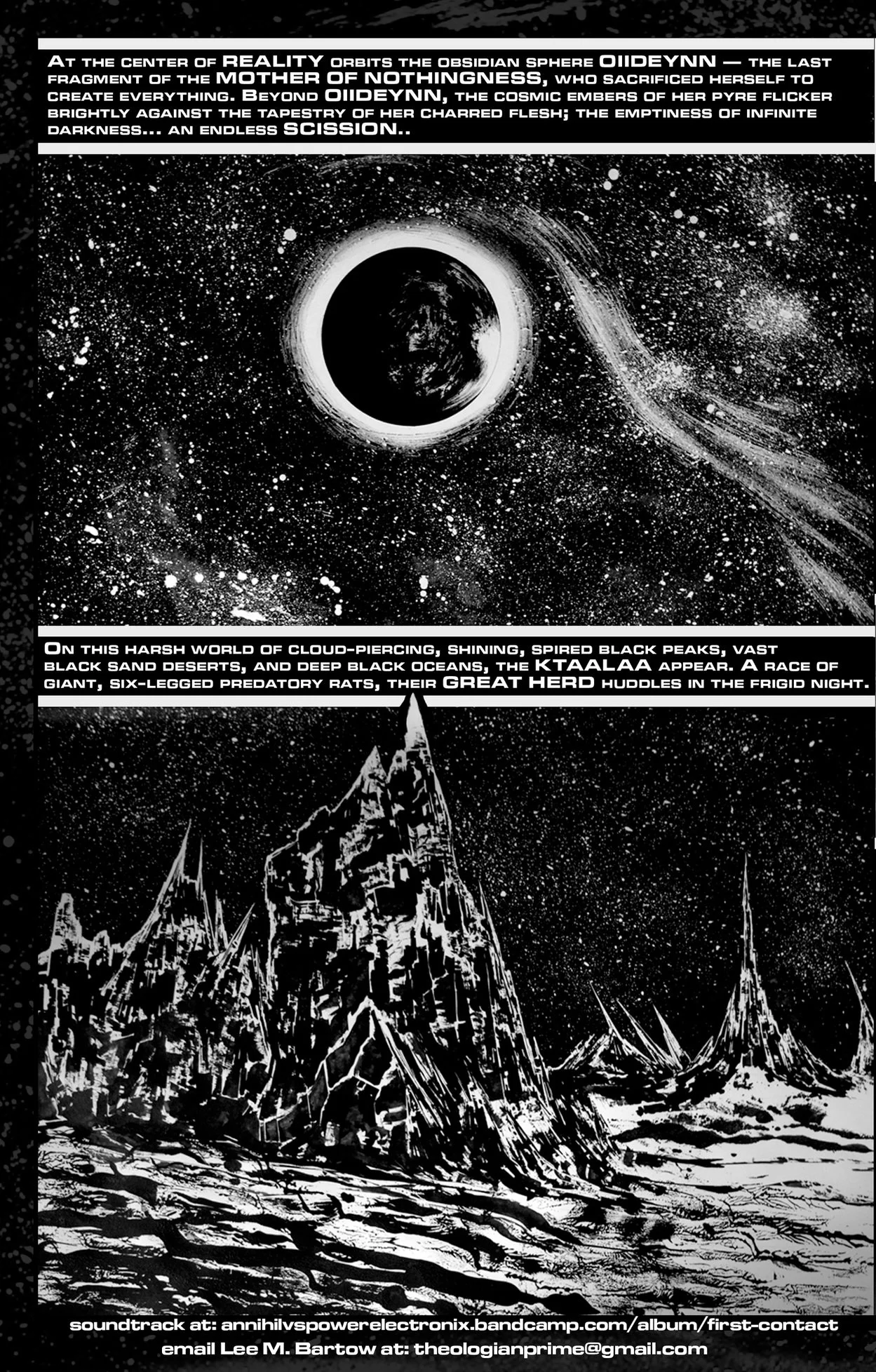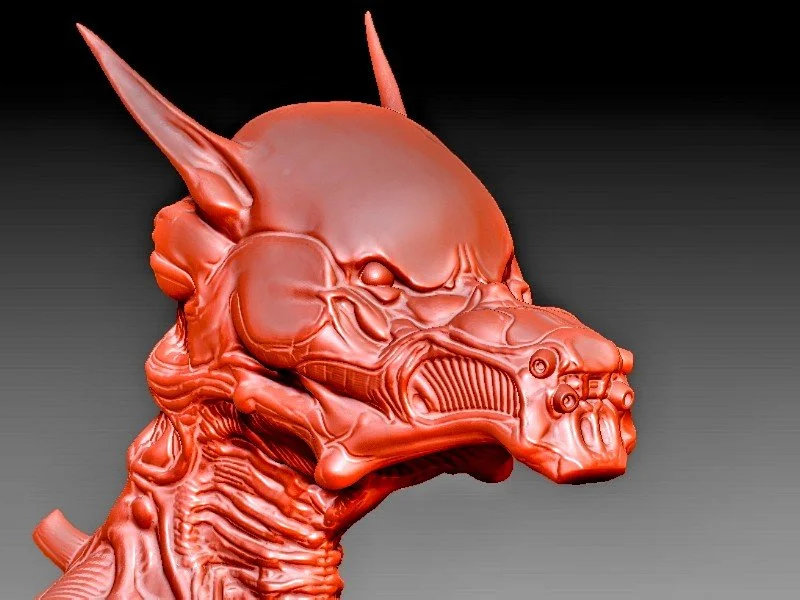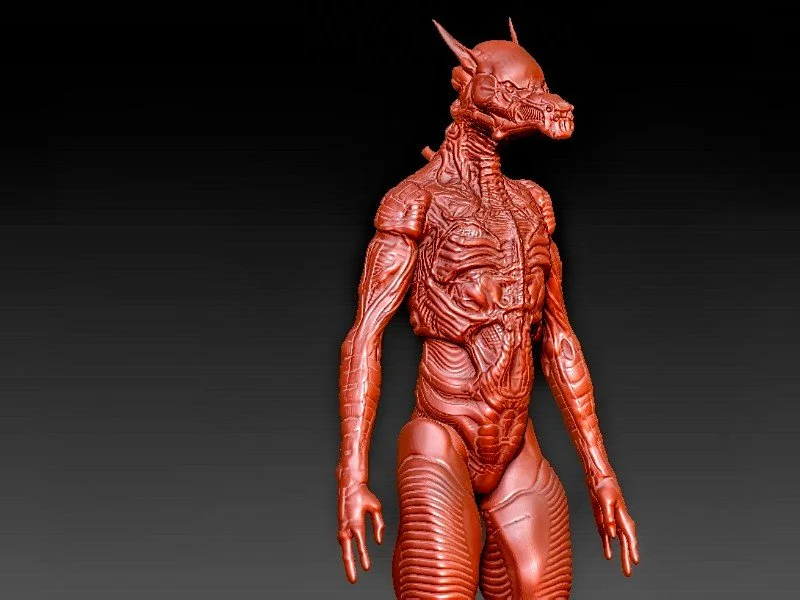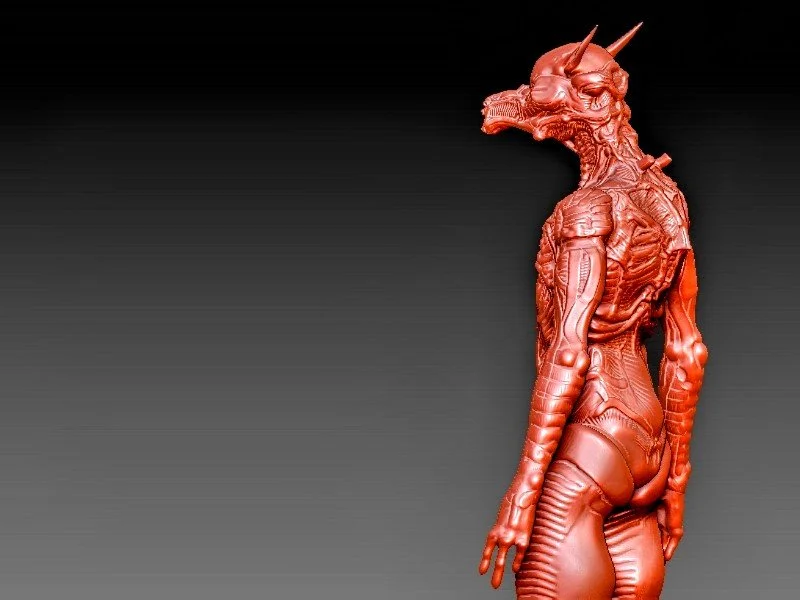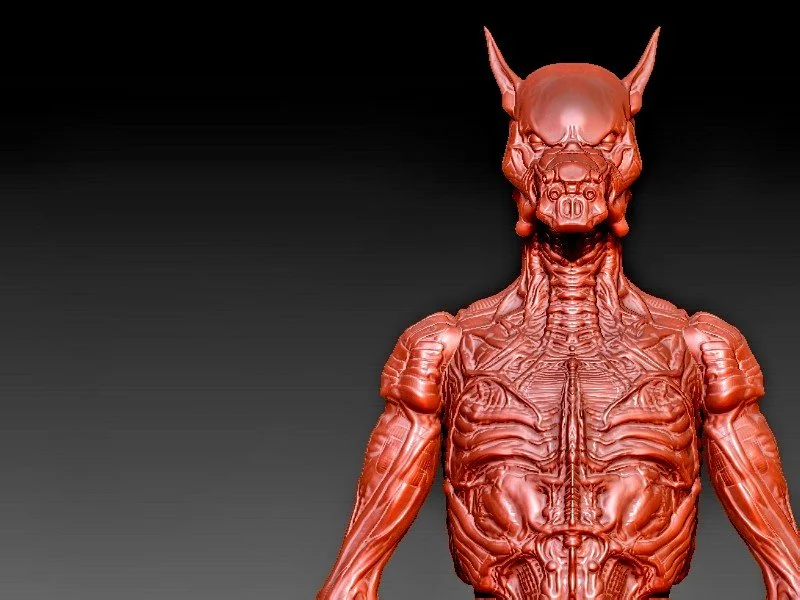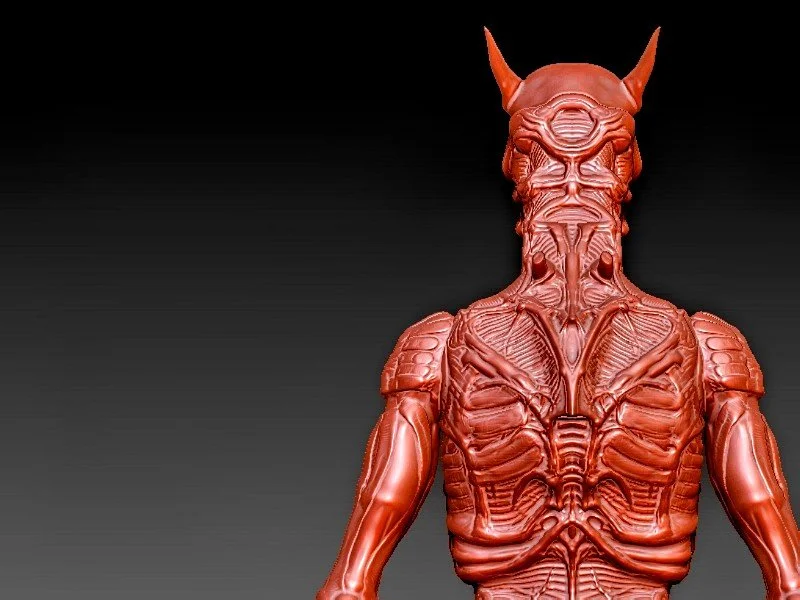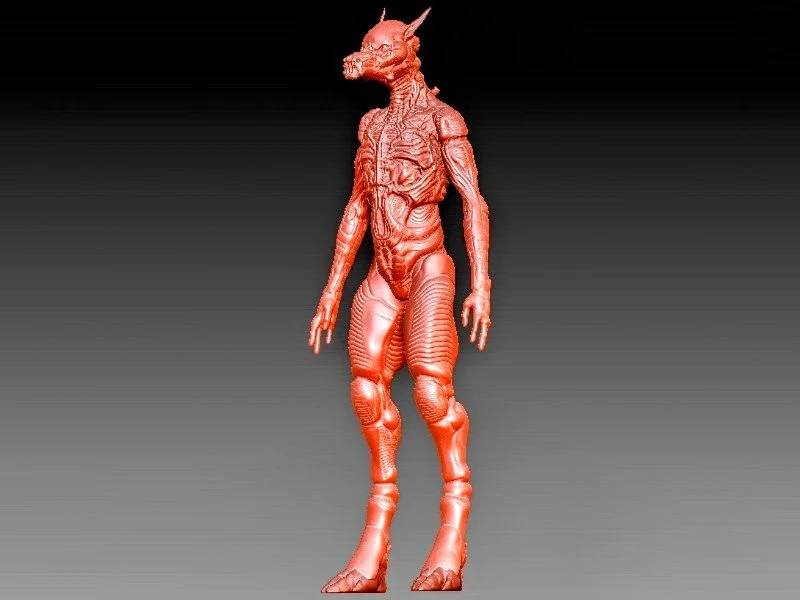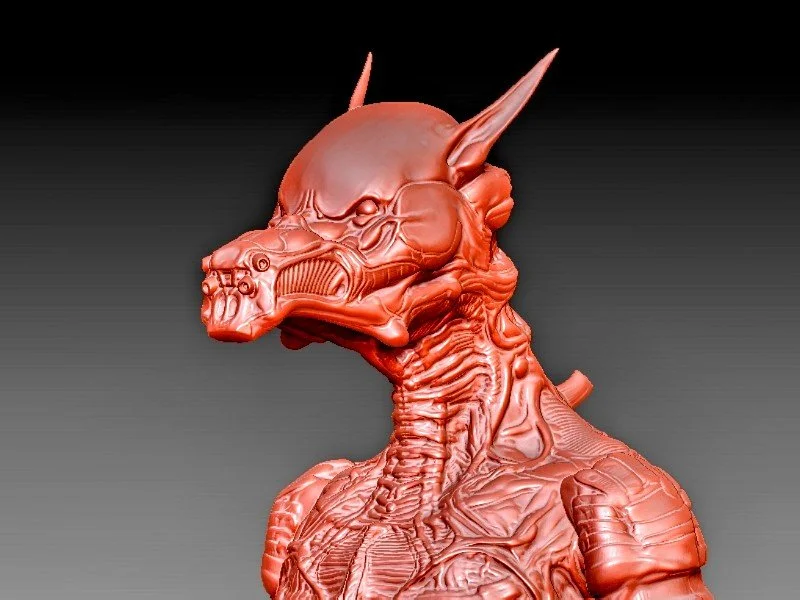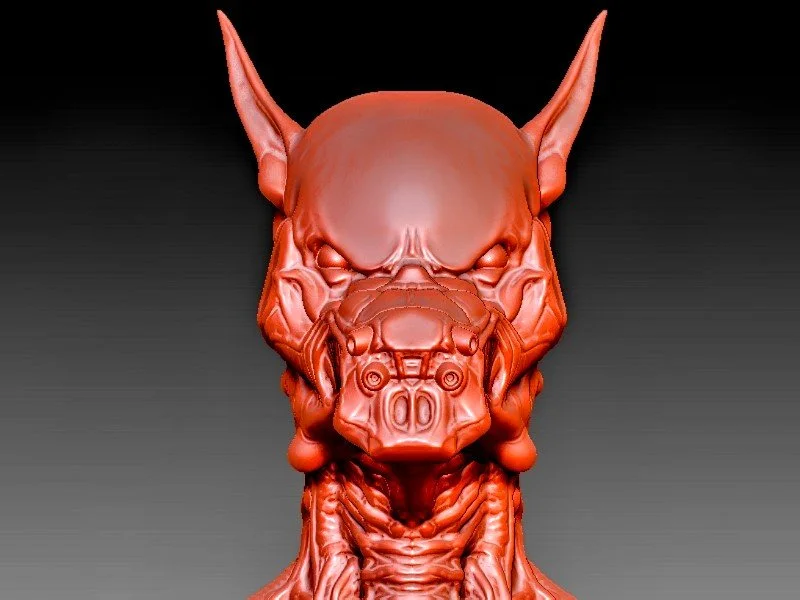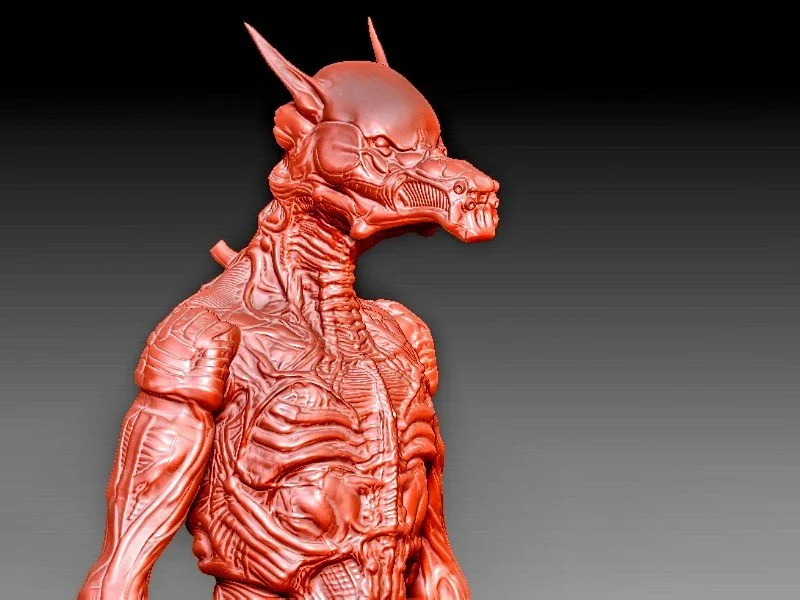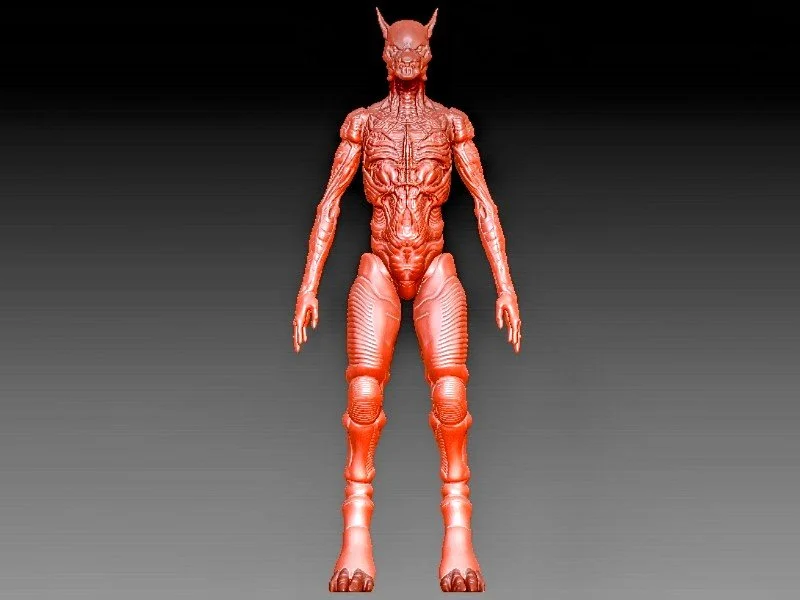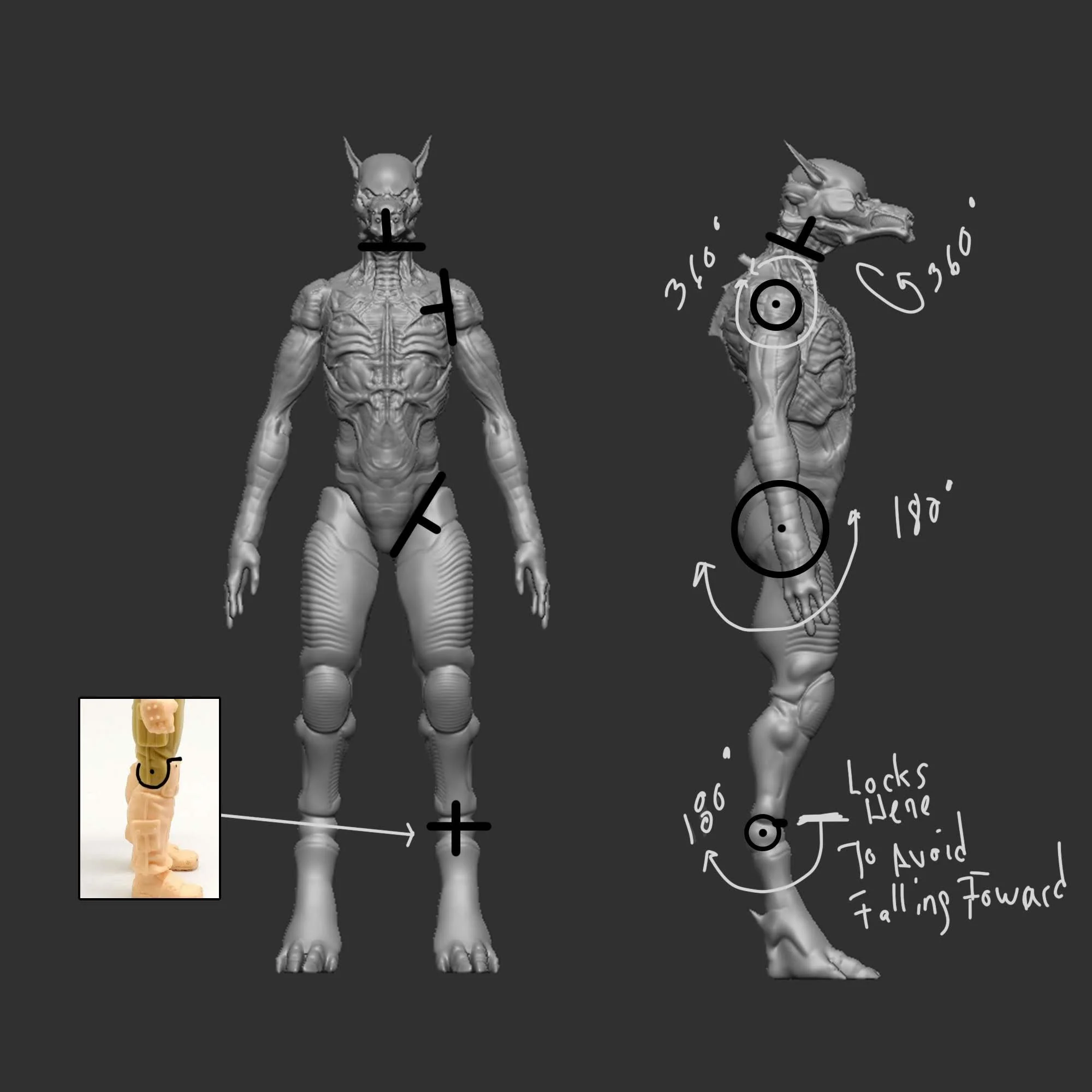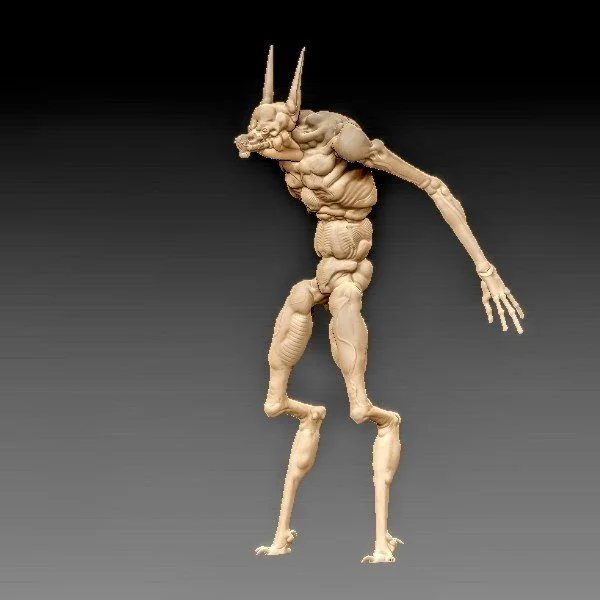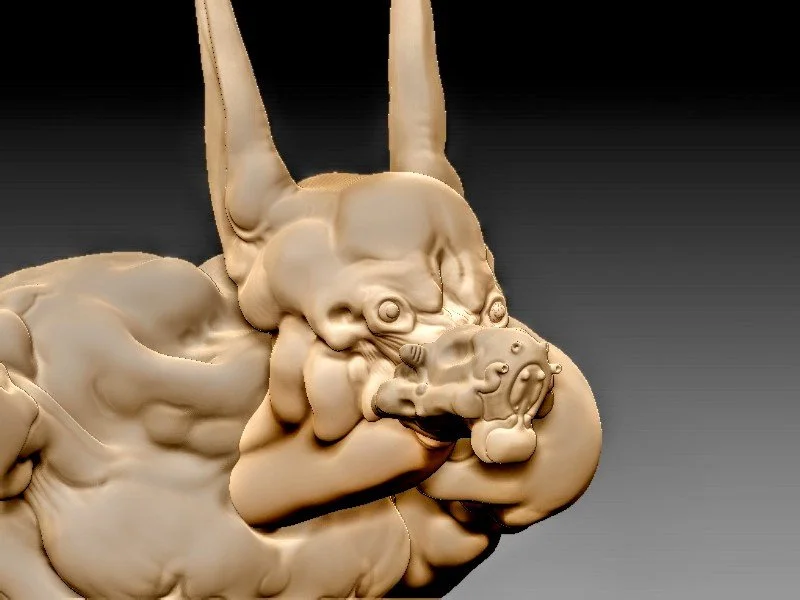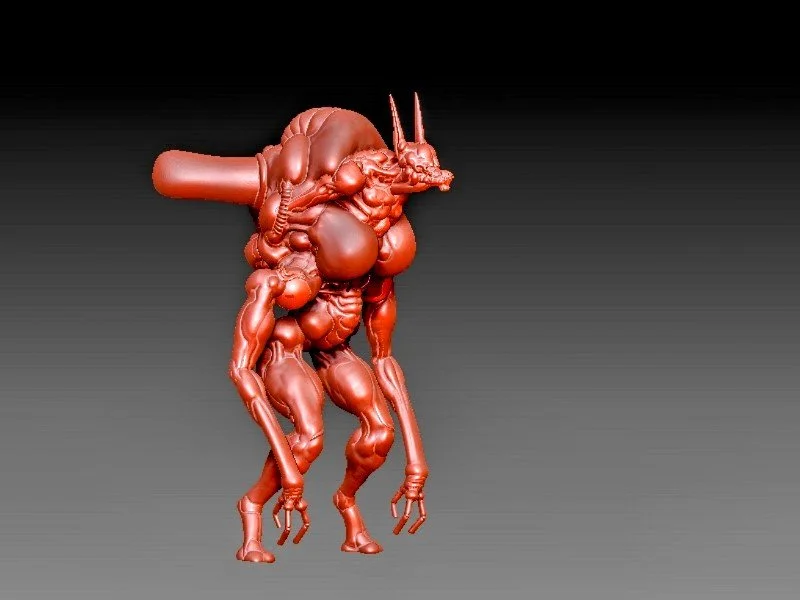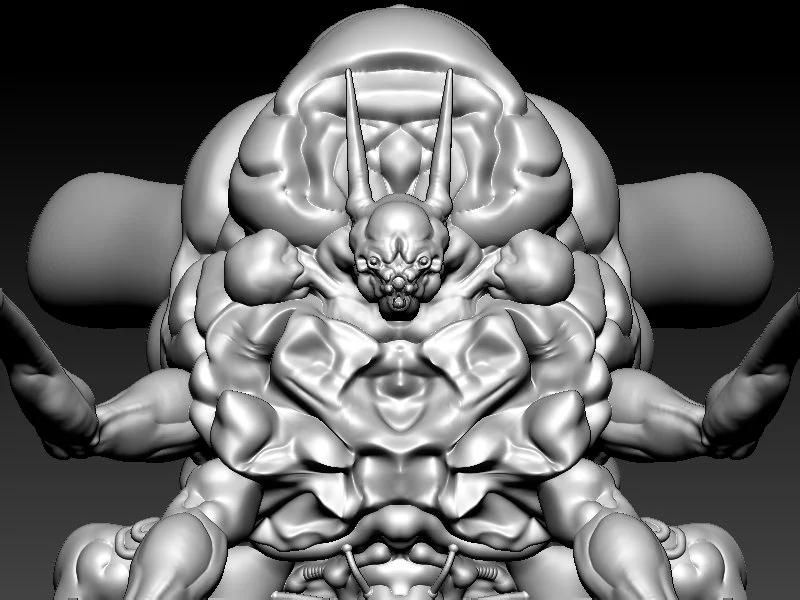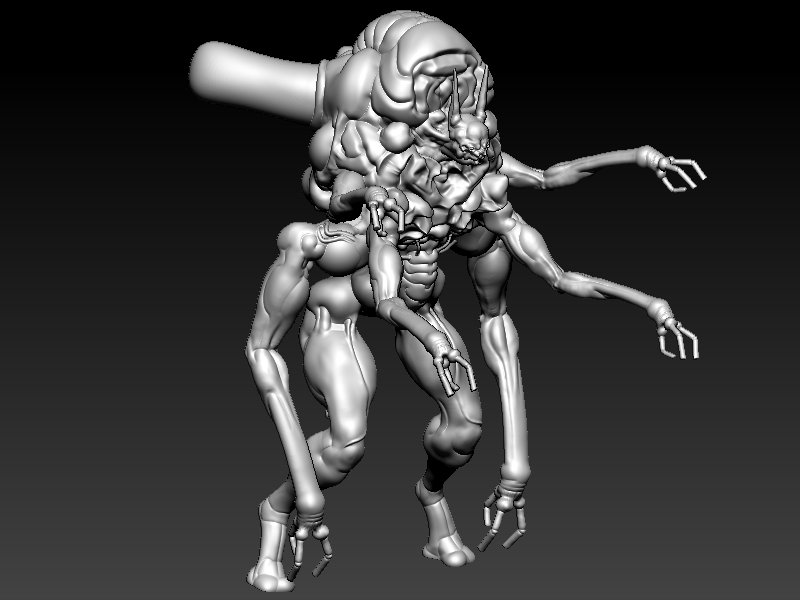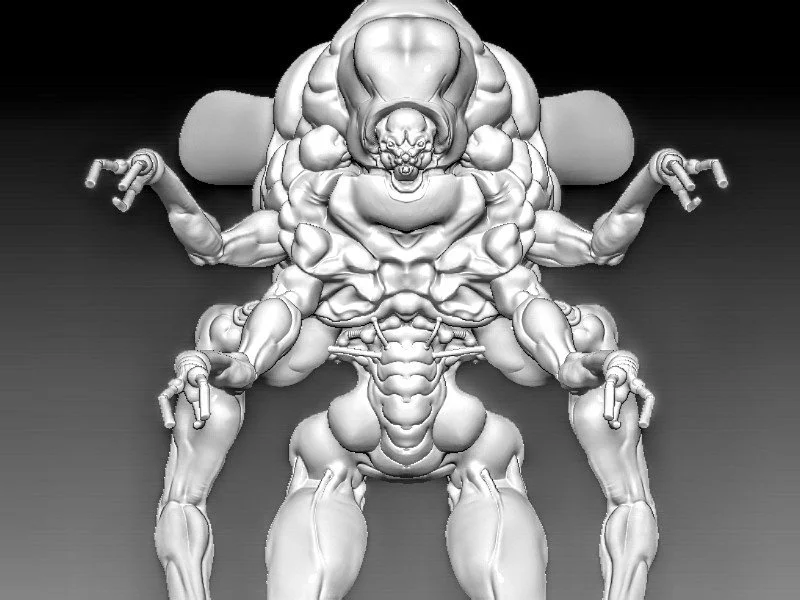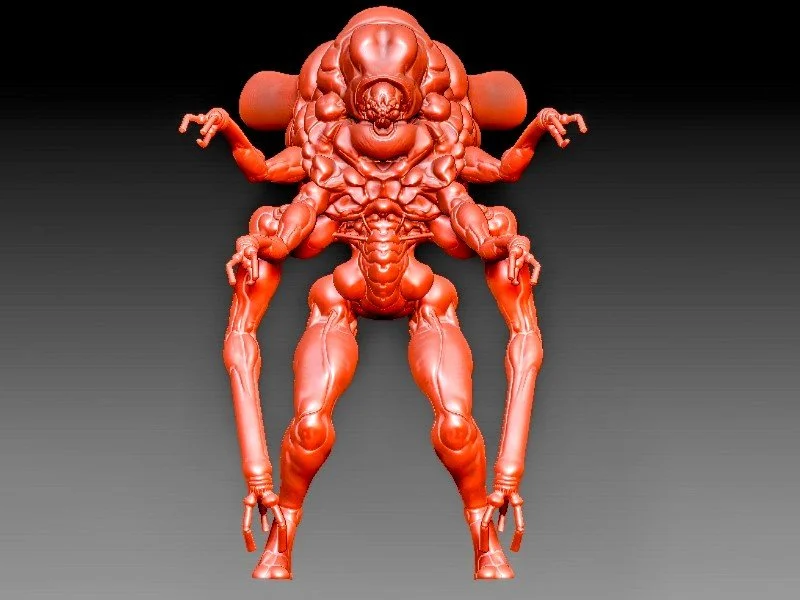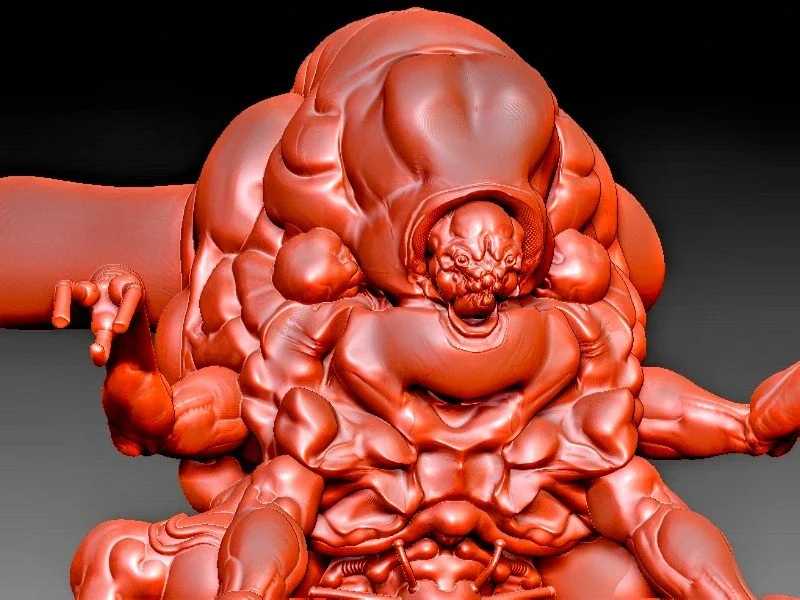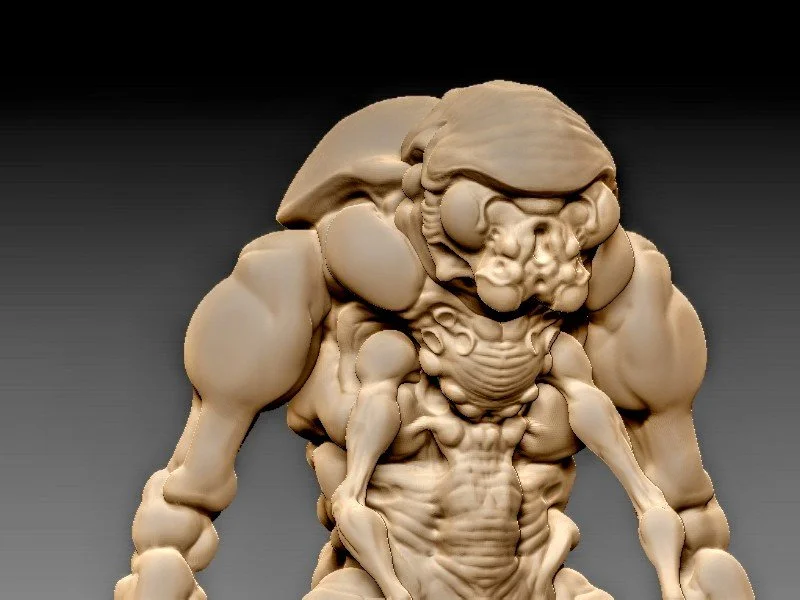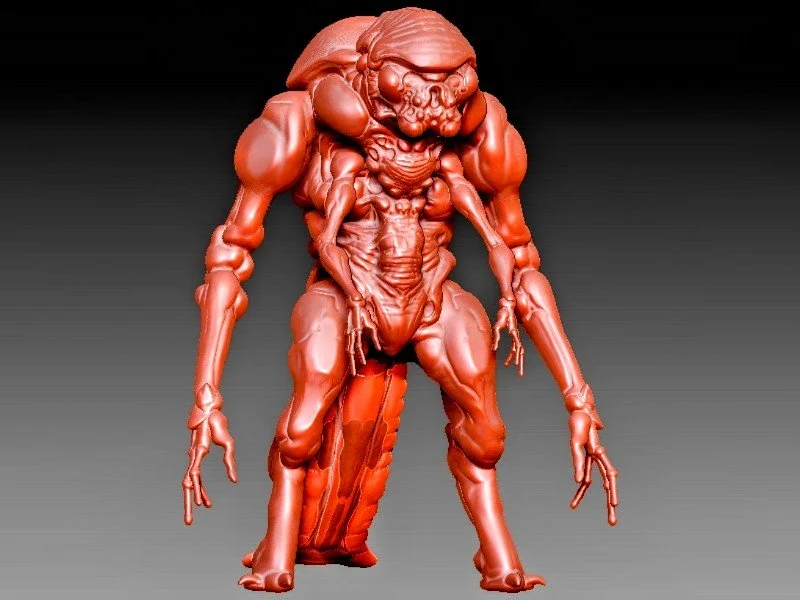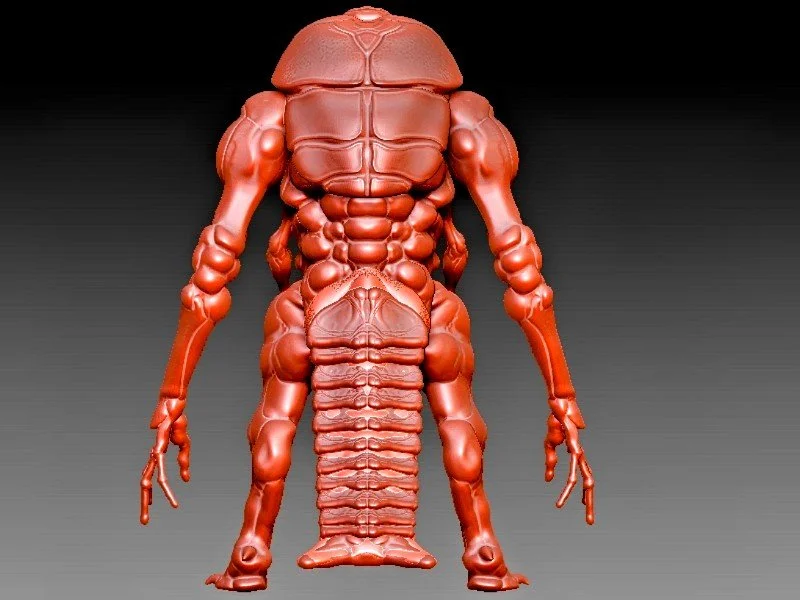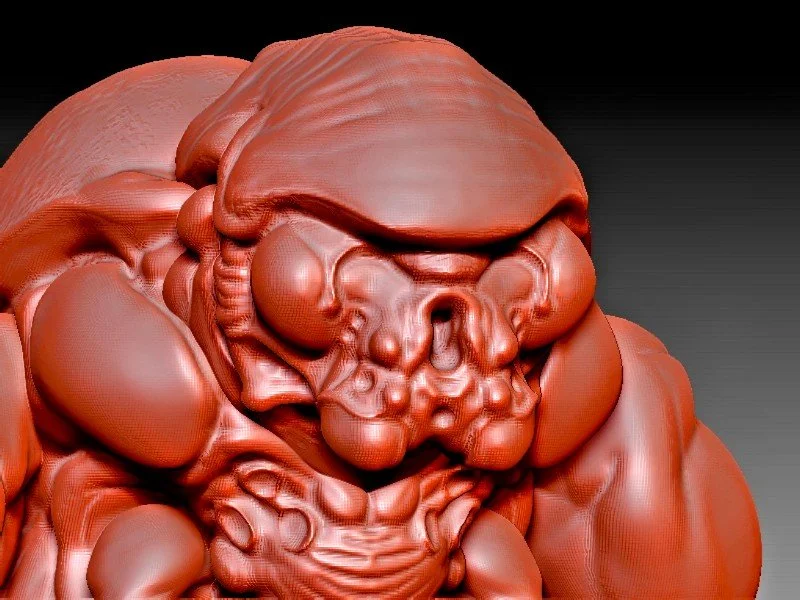CHILDREN OF OIIDEYNN - EXPANDED
At the center of reality, in the endless Scission, orbits the obsidian sphere OIIDEYNN. In this inhospitable place, the Ktaalii evolved from a race of giant, six-legged rats called the Ktaalaa. The works of Edgar Rice Burroughs, in his Barsoom novels, inspired me as a pre-teen to imagine all manner of hexapodal beasts. Dougal Dixon’s 1981 book, After Man: A Zoology of the Future similarly influenced this story element, with its speculative packs of wolflike predator rats, hunting giant rabbits that had, over time, evolved into herds of long-necked grazing animals. The Ktaalii’s appearance was certainly heavily informed by NEMESIS THE WARLOCK, as drawn by Kevin O’Neill in 1984. The idea of “Molecular Technology” that is incorporated into Ktaalii biology and allows for physical transformations, and the spontaneous generation of weapons from the body, was likely initially inspired by John Carpenter’s THE THING (1982). Elements from David Cronenberg’s VIDEODROME (1983), STAR TREK: TNG (1987) and BABYLON 5 (1994) all likely cemented these ideas in my head over time. James Cameron’s TERMINATOR 2 (1991), with its transmutational “liquid metal” killing machine, would influence several corners of media for decades to come. Comic characters such as VENOM, as written and drawn by Todd McFarlane in the 90s, as well as McFarlane’s SPAWN, both have shapeshifting elements, as do a host of characters from other early IMAGE series. William Gibson’s 1996 novel Idoru made a lasting impact on me, with its nanotech assembler machine and “living” skyscrapers as central plot conceits. It’s fascinating how, over the decades, so much science fiction media has come to treat nanotechnology as an ever-more popular trope. More recently, latter day MCU fare has really run rampant (or roughshod) with the concept. What I find unique about the Ktaalii Molecular Technology, is that it would be impossible without their incredible psionic abilities, focussed into a power source, by the entire civilisation. The machinery then bolsters those inherent abilities, in a moebius strip of infinite potential, thus allowing the Ktaalii to puncture through the fabric of reality. Unfortunately, the result isn’t quite what they’d expected.
After nearly driving themselves to extinction through endless global war, the Ktaalii strove to collectively change the path of their civilisation, dedicating themselves to science, and to unlocking the mysteries of reality itself. They had developed Molecular Technology, powered by their incredible capacity to manipulate their environment through will alone, but now instead of creating weapons of devastation, they dedicated themselves to the act of creation. They become gods, generating an entire artificial ecosystem to replace the one they’d destroyed. When I was in middle school, one morning I was walking to school and came across a squirrel that had been hit by a car. It was still breathing, its nostrils filled with blood. Even if I had the brain capacity at the time to scoop it up and take it to an adult, I have no hope that it would have survived. I found a stick, and pushed it to the curb, in tears. Where I grew up, and really all over this region, squirrels are in great abundance. I love them. This event has stayed with me, and at some point as a kid, I imagined “squirrels that can fight back” — thus, the origins of the Ktaalii as having evolved from rats. There is some sort of ecological “message” in the subtext, I guess…
The Ktaalii are a species with multiple Castes, each one with idiosyncratic physiological traits according to their practical and societal function. The Military Caste, from which this individual originates, is known as a Warmaker. Standing roughly three metres tall by human proportions, their bodies are lean and muscular, and as with all Ktaalii, encased within symbiotic armour, or Autoreactive Molecular Operational-Neuraxial Lattice, an Engineered Organism genetically embedded within the wearer, which instantaneously responds to any threat and can alter itself to assume any state of matter or energy. The Ktaalii would need such a technology when their world was suddenly besieged by the Flock of Xælhéq. A congregation of Extra-Spatial parasites traversing the Scission, starving for psionic energies. Discovering the Labyrinth, they are convinced the Ktaalii are their long-lost gods calling them to paradise. The Flock follows the Labyrinth’s divine energies through countless Spatial Strata to its point of origin: OIIDEYNN. Appearing in orbit above the sphere, the Flock is subjected to an instantly hostile response from the Ktaalii, in defense of their home. I could have hardly imagined in the late 80s when I was coming up with these ideas, that a great many years later, the HALO video game franchise would suddenly throw something just like this into the mix… Before my adversaries were known as the Flock, they were the Swarm, and the Blight, I believe my original name for them was Voidleeches. All of these names have probably been used time and again in a variety of sci-fi or fantasy media. When it comes to beings “from beyond,” obviously Lovecraft stands as a major point of reference in CHILDREN OF OIIDEYNN, my own take on cosmic horror. I was certainly influenced in the 90s by Mike Mignola’s HELLBOY comics, and certain of my concepts took on more solid form after reading the 2001 CONQUEROR WORM storyline, wherein the Nazis are using the brains of dead psychics to communicate with otherworldly beings using arcane technology. Interestingly enough, the first HALO game was released only months after that series was published.
I became aware of Jase Daniels in the spring or summer of 2019, when my partner Gretchen and I opened a record shop. I’d spent the previous two years working in the warehouse at Toywiz (one giant OSHA violation), at which point a lifetime of manual labour jobs began to take their toll, and suddenly I was dealing with constant pain in my neck and spine. I couldn’t have known at the time what was to come. I left my job, and with little other choice, we tried our luck at fulfilling what had been a long-held dream of mine. One day, the 3D artist John “Twyg” Hyde posted photos of some of Jase’s little sculpted creatures, the “Nubblings” - I contacted Jase and asked to carry them in the shop. Over time as we continued our relationship (the Nubblings were big sellers), it came to light that another of Jase’s many disciplines was industrial noise, something near and dear to my heart. Our aesthetic and sonic venn diagram was more like a single circle. To date, I have released two albums by GROT; a full-length cassette in 2021, and a split with fellow UK noiser PRIOR in 2022. It seems that Jase and I are brothers under the skin; both of us currently experiencing chronic pain due to spinal injuries.
Jase actually turned me down the first time I asked him about working on this project with me. It was still very early into our relationship, so I understood. I am immensely grateful that he eventually chose to help me bring this character, and the others that he’s worked on, into three dimensions. Imagining something for my whole life, but feeling powerless to bring it to fruition because of my own limitations… seeing these creatures take form has been such a gift, and has pushed me to pick up the old stylus and, at least a year or two after giving up, take another stab at 3D sculpting. It seems Jase and I have inspired each other once again. We currently have three characters in progress, maybe four if Jase can find those files.
What happened to that third pair of limbs when the six-legged Ktaalaa evolved into the bipedal Ktaalii? Well, originally the idea was that their first and second pair of legs had fused during that evolution, into arms. When I would draw Ktaalii as a teenager, I took inspiration from HR Giger’s work on Alien, and in particular those incredible hands, with their double thumbs and fused fingers, informed this concept. While not present in the current design, the idea is that the Ktaalii hand possesses a center digit, longer than the rest, as the last vestige of those long-lost appendages, that conceals a long, retractable, claw. I remember from my drawings in the late 80s that each finger originally had retractable claws, probably inspired by both Marvel comics’ 1982 Wolverine limited series by Frank Miller, and the 1987 PREDATOR film.
The Ktaalii have venomous saliva that necrotises organic tissues in order to help pre-digest their prey. This is a throwback to their Ktaalaa ancestry, and isn’t particularly necessary for such a technologically advanced species. However, they have adapted this trait into an offensive weapon.
This device collects the substance in storage tanks under the chin, and can project the acidic saliva from ports in the front.
Before evolving into the Ktaalii, the Ktaalaa existed as a Great Herd, huddling together in the deep cold of Oiideynn’s endless night, until the First Sunrise drove them to race across the black plains of Oiideynn, devouring everything in their path. Is it a creation myth, or a true collective memory? Upon the Second Sunrise, they find themselves walking upright. The Ktaalii’s cousins, the Dlraykiid, have evolved alongside them, from those Ktaalaa that sought shelter from the First Sunrise in the water, adapting to life in the black oceans of OIDEYNN. Separately, each civilisation raises their own cities and forge matriarchal societies, one on land, one beneath the waves. After perpetual wars nearly drive them to extinction, the Ktaalii dedicate themselves to globally combine their psionic abilities, manipulating reality with new Molecular Technologies. With the aid of the Dlraykiid, they create a conduit that instantiates itself, like a fungus, beyond their own Spatial Strata, into the farthest edges beyond the borders of their reality: a Labryinth. In recent viewings of FORBIDDEN PLANET, I came to realise just how influential some of the concepts present in that film had been to this story. The idea of a species that remembers its entire history back to the beginning was an early aspect of the story going back to when I was a teenager. Then it showed up in AVATAR. So many times in my life have I encountered ideas from my own storyline in other media that came later. It amazes me how we all drink from the same well (in one of my series of short stories from my college writing days, the Internet was called “The Matrix” — imagine my surprise in 1999 when ads for a certain Keanu Reeves film started circulating). Obviously no concept is truly original, but the joy comes from how we each interpret the standards set down before us.
Another toy line that was definitely an inspiration for me was the POWER LORDS, released by Revell in 1983. That Christmas, I got every figure from that first wave, now long-since lost to my parents’ dustbins. The original character designs were done by renowned sci-fi and fantasy artist Wayne Douglas Barlowe, whose work has, in general, served as a massive influence on me throughout my life. Just as Edgar Rice Burroughs implanted in me a love of six-legged aliens, Wayne Barlowe instilled in me a love for creatures with fused limbs.
I was born in the United States in 1971, and action figures have been a part of my life since the first wave of Star Wars toys hit the shelves. I’ve collected for as long as I can remember, but it wasn’t until 2017 that it turned into a major obsession. I spent a couple of years trying, unsuccessfully, to sculpt my own characters in a variety of sculpting media, including digitally with both Zbrush and Oculus Medium. Way back in 2014, I took a ceramics class at the local arts centre, with the intention of creating masters sculpts for what you’re seeing now. Everything I tried was a disappointment. But, I realised, if I took existing figures and modified them into my own characters, that would be easier than starting from scratch. This was the birth of BROADSWORDS, intended as a series of vignette stories using action figure photography to tell a narrative. It was at this time that I discovered a worldwide community of amazing artists, customisers, and collectors had been building for years, doing exactly what I was just getting started on. This happened to coincide with FOUR HORSEMEN STUDIOS attempting to launch a new series of POWER LORDS action figures. As a big fan of their earlier 4-inch incarnation of the property, I was very emotionally invested in this project, and pre-ordered a LOT of the figures. Unfortunately, the campaign did not achieve its financial goal, and the line was dropped. My disappointment lasted years until late spring 2023, when the first COSMIC LEGIONS figures, the company’s answer to the POWER LORDS, were delivered into my eager hands.
Because the Ktaalii can “grow” various weapons, defensive systems, and additional armour from their own bodies via the Molecular Armour, the plan is to create an array of additional accessories that can be attached to the base Buck.
Blue Inferno Figures has created an articulated head and neck peg from Jase’s Ktaalii Warmaker sculpt that’s compatible with
Legions figures from FOUR HORSEMEN. These prints will be available later in 2024.
The second limited print run to come this year will be our prototype with seven points of articulation. I had this engineered in 2023 by EBerry Studio.
The eventual goal for our prototype stage will be to have new, more complex articulation engineered by Blue Inferno Figures.
More stuff is in the works, building up toward a late 2025 Kickstarter campaign to have at least one figure mass produced overseas.
Kenner’s original 1979 ALIEN action figure was the primary inspiration for this articulation scheme, although I also wanted to see what it might be like to have the ankles move. I’m generally satisfied by the engineering, but I want these figures to one day be “super-articulated”, capable of being contorted into all sorts of positions.
When I began what would become my action figure collection in 2017 under the BROADSWORDS banner, I was particularly obsessed with the “Synthetic Human” action figure, designed by manga artist Tsutomu Nihei (BLAME!), and produced in both 1/6 and 1/12 scales by 1000Toys. As far as I’m concerned, these are among the pinnacle of action figure articulation, and it’s what I ultimately want to emulate for CHILDREN OF OIIDEYNN. BLAME! has also been a major inspiration for me, and I highly recommend you read it.
The articulated prototype features simple joints at the neck, shoulders, hips, and ankles.
The third figure in our prototype series is thIs member of the Ktaalii Engineering Caste, or Mechempaths. This caste is responsible for the development and maintenance of the multitude of Engineered Organisms, created via Molecular Technology, that function to support Ktaalii society and infrastructure. Following the invasion of Oiideynn by the Flock, they have become dedicated once more to the machinery of war.
Here, you can see the Ktaalii mouthparts. The lower jaw extends to attach to prey, while glands around the mouth inject its necrotising, venomous saliva.
The Mechempath’s Molecular Armour is more aesthetically subtle than that of the Warmaker, but no less powerful. You’ll see more of this below.
The Molecular Armour expands around its host to create a more robust defensive or utilitarian system. We plan to get a few prints of this massive beast later in 2024, and it is my hope to see an articulated version in 2025. This “biomech” started as an original design that Jase had come up with independently, and he has graciously allowed me to adapt it as part of CHILDREN OF OIIDEYNN. I actually added the Mechempath to his model myself, making several alterations in ZBrush, such as the two pairs of additional arms, and sculpting the “cockpit” area around the Ktaalii.
The Dlraykiid are another species who evolved from the Ktaalaa, however they are adapted to life in the depths of Oiideynn’s black oceans. While the Ktaalii waged endless wars on land, the Dlraykiid developed an advanced society beneath the waves.
What you see here is actually Molecular Armour around its Dlraykiid host. This allows them to function outside of their native undersea environs.
The two smaller arms and the tail are the only visible parts of its true anatomy. The figure, when it’s eventually produced in articulated form, will feature another, smaller head beneath this “helmet,” which will appear closer to that of a Ktaalii, although with a morphology more suited to a marine environment.
When walking on land, the Dlraykiid uses its massive tail as a third ambulatory limb; kangaroo’s hips are physically incapable of independent movement, and so when not hopping about, they use their tail to walk. The Dlraykiid would move in a similar fashion, although far more quickly, and that much more terrifying to see barreling toward you.
The plan is to include two variant helmet/heads, one with the sensory organs and mouth parts extended, and this one, where these appendages have been reabsorbed into the face. The story calls for the Dlraykiid to have an array of long tentacle-like feelers and whiskers extending from the back of its head, each pair serving individual utilitarian and defensive functions when navigating the sightless depths of their subaquatic civilisation. It will be an interesting challenge when the time comes to sort out how this would work on a toy.

